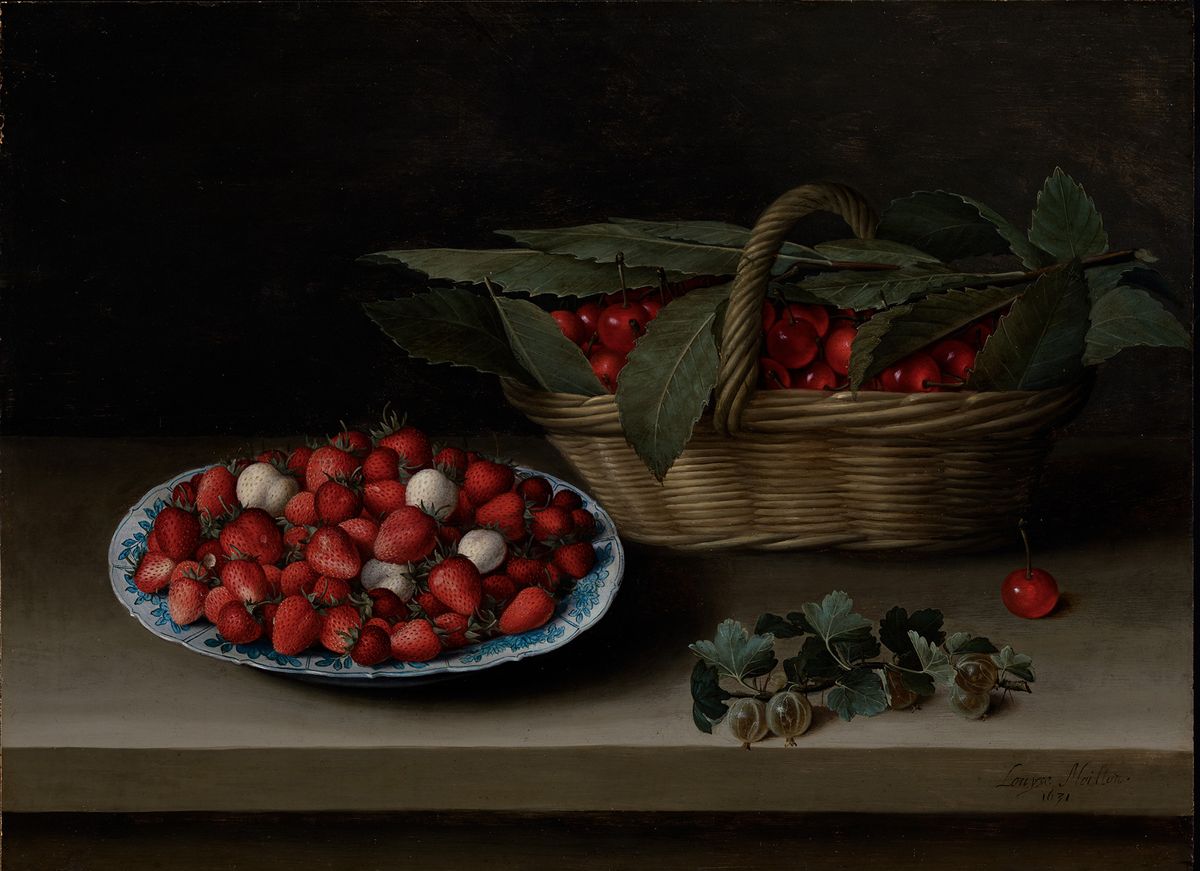A rare still life by the 17th-century French painter Louise Moillon never before seen in public is now on display at the Kimbell Art Museum in Fort Worth, Texas, providing a window into the skills of the enigmatic artist.
Still Life with a Bowl of Strawberries, Basket of Cherries and Branch of Gooseberries (1631) depicts an enticing spread of freshly picked fruit, and had been unknown to scholars until its appearance at a Paris auction in March 2022. The oil painting went to an American collector in a sale that set a new world auction record for Moillon; in October, the collector sold the work to the Kimbell through the New York-based dealer Adam Williams.
“The Kimbell was interested in acquiring the work first and foremost because of its outstanding quality and condition, and because of how beautiful it looks hanging in the Kimbell’s Louis Kahn-designed galleries,” says Eric Lee, the director of the Kimbell. “It is sure to become an audience favourite.”
The painting, whose acquisition is one of several marking the museum’s 50th anniversary, is the first 17th-century French still life to enter the collection. Lee says it “contributes a new dimension” to the collection’s French paintings from the period, which includes works by Nicolas Poussin, Georges de La Tour and the Le Nain brothers. “It is a plus that Moillon is a female artist,” he adds.
Born in 1609 or 1610 to a Protestestant family in Catholic France, Moillon may be a fairly obscure name today, but she achieved renown in her lifetime for her trompe l’oeil still lifes, which capture fruits and vegetables as mouthwatering jewels. She sold her first work in 1629—a painting of a bowl of peaches—after exhibiting it in Grenoble, and is thought to have received commissions from Louis XIII of France and Charles I of England, who owned five of her fruit paintings. Today, her works are in the collections of the Louvre, the Art Institute of Chicago, the Los Angeles County Museum of Art and the Norton Simon Museum in Pasadena.
Growing up in the Parisian district of Saint-Germain-des-Prés, a safe haven for Protestant refugees, Moillon was exposed to the quiet tabletop scenes of painters from the southern Netherlands who were among those seeking refuge from religious persecution. She herself came from a family of artists: her father, Nicolas, was a painter, and her brother, Isaac, would become known for his Baroque paintings. But scholars believe it was her stepfather, François Garnier, a still-life painter and dealer, who trained her. By the age of 20, she had painted 13 still lifes, mostly of fruit, according to an inventory taken following her mother’s death in 1630.
Since the early 20th century, Still Life with a Bowl of Strawberries has remained in the collection of a family in central France. A label on its former frame reads “J-A Ponsin, Rue Fortuny, Paris”, suggesting that it may have once been in the collection of Joseph-Albert Ponsin—an actor, stained-glass artist and founder of the Bourjois cosmetics company. La Gazette Drouot predicted a bidding war when the work went to auction in March; it sold for €1.6m (including fees), more than eight times its high estimate of €200,000, and surpassing Moillon’s previous record of €1.1m (with fees) at a Sotheby’s Paris auction in 2016.
The Kimbell declined to say how much it paid for the work, as did Williams, who added that “this is the finest picture by Louise Moillon to come on the market in the last 50 years”.
Dominique Alsina, who authored Moillon’s catalogue raisonné, has established 69 authentic paintings. Most of these, which the artist signed “Louyse Moillon”, date from between 1629 and 1637. Her final known work dates to 1641, a year after she married Étienne Girardot, a timber merchant. The Kimbell suggests: “Perhaps the wealth and social status of her husband and her extensive family circle discouraged her from continuing her profession.” Writing in France in the Golden Age, historians Pierre Rosenberg, John Wyndham Pope-Hennessy and Marc Fumaroli speculate that “the archaic style of her work had gone out of fashion”.
Moillon may not quite yet be enjoying a revival, but she is increasingly getting museums’ seals of approval. In 2021, the Toledo Museum of Art purchased a Moillon still life of lemons and oranges. The Baltimore Museum of Art is currently exhibiting, through the summer of 2023, a market scene from 1630 as part of a partnership with the National Museum of Women in the Art; and a painting of cherries, plums and melon is a standout at a monumental still-life exhibition at the Louvre.
At the Kimbell, Still Life with a Bowl of Strawberries is now on view in the museum’s south gallery, next to a still life of an extravagant bouquet by the Dutch painter Jacques de Gheyn II. “Though the Moillon is more sober than the exuberant De Gheyn, the two paintings look wonderful near one another,” Lee says, “and represent two vastly different approaches to still-life painting in the early 17th century.”


